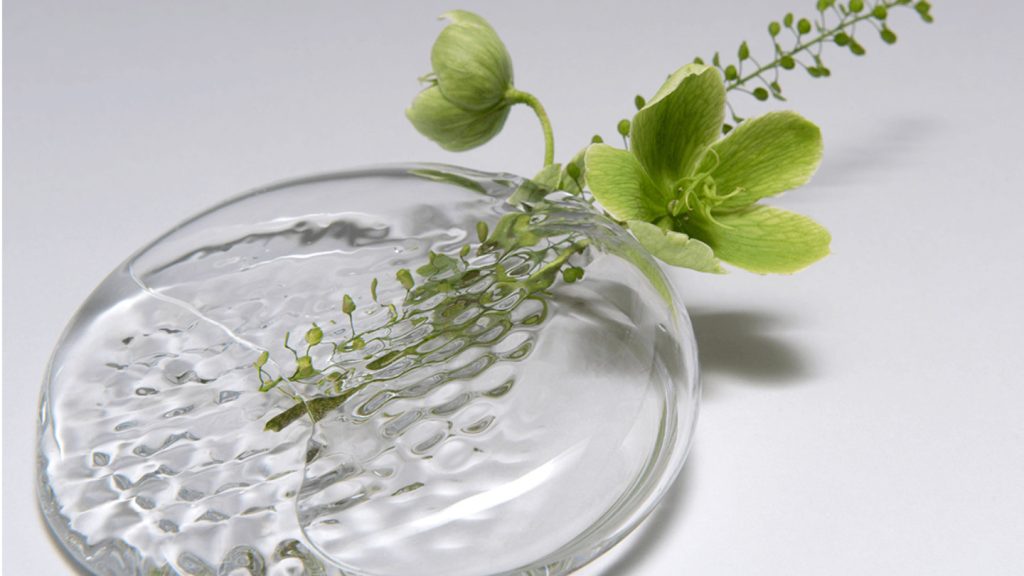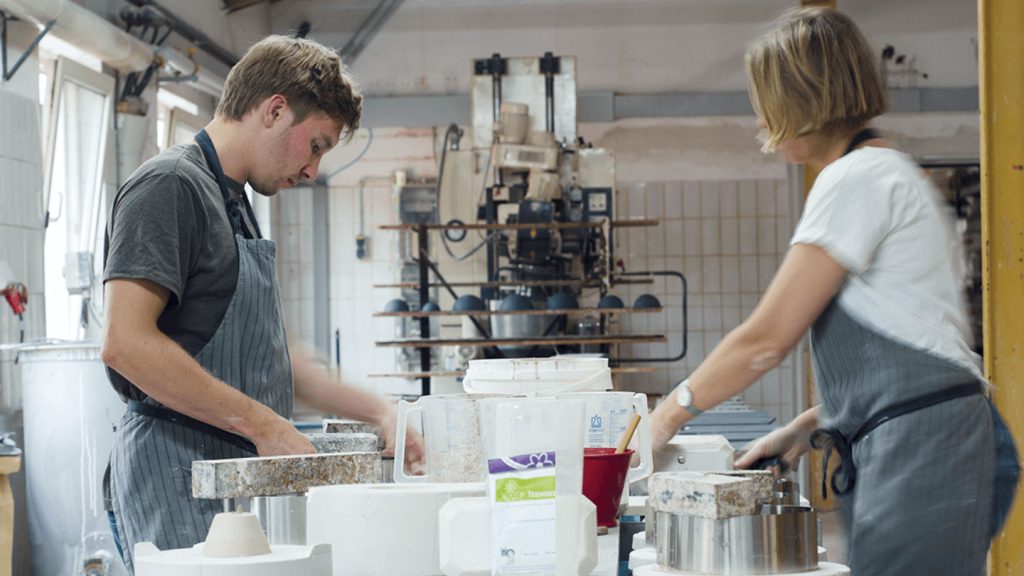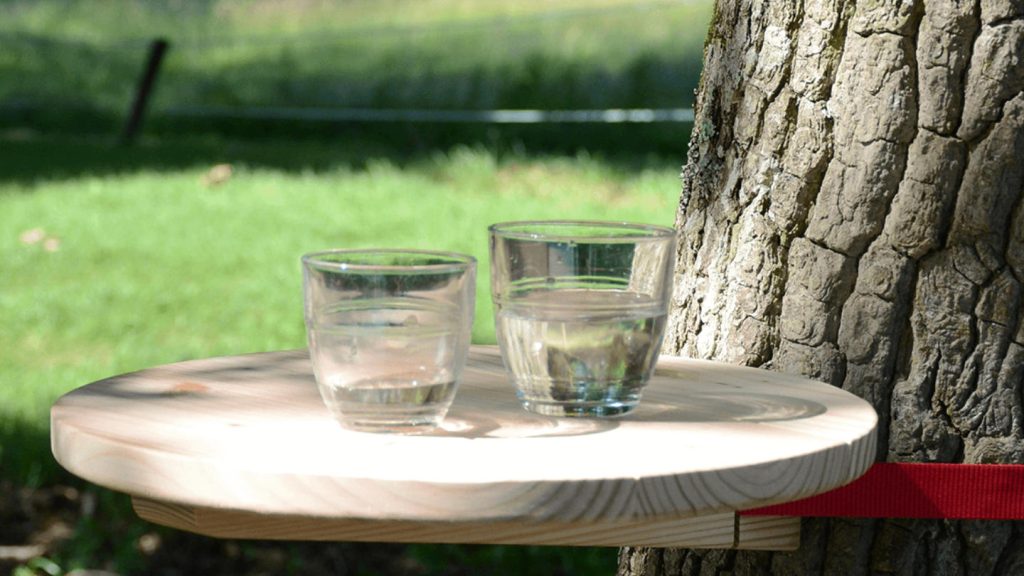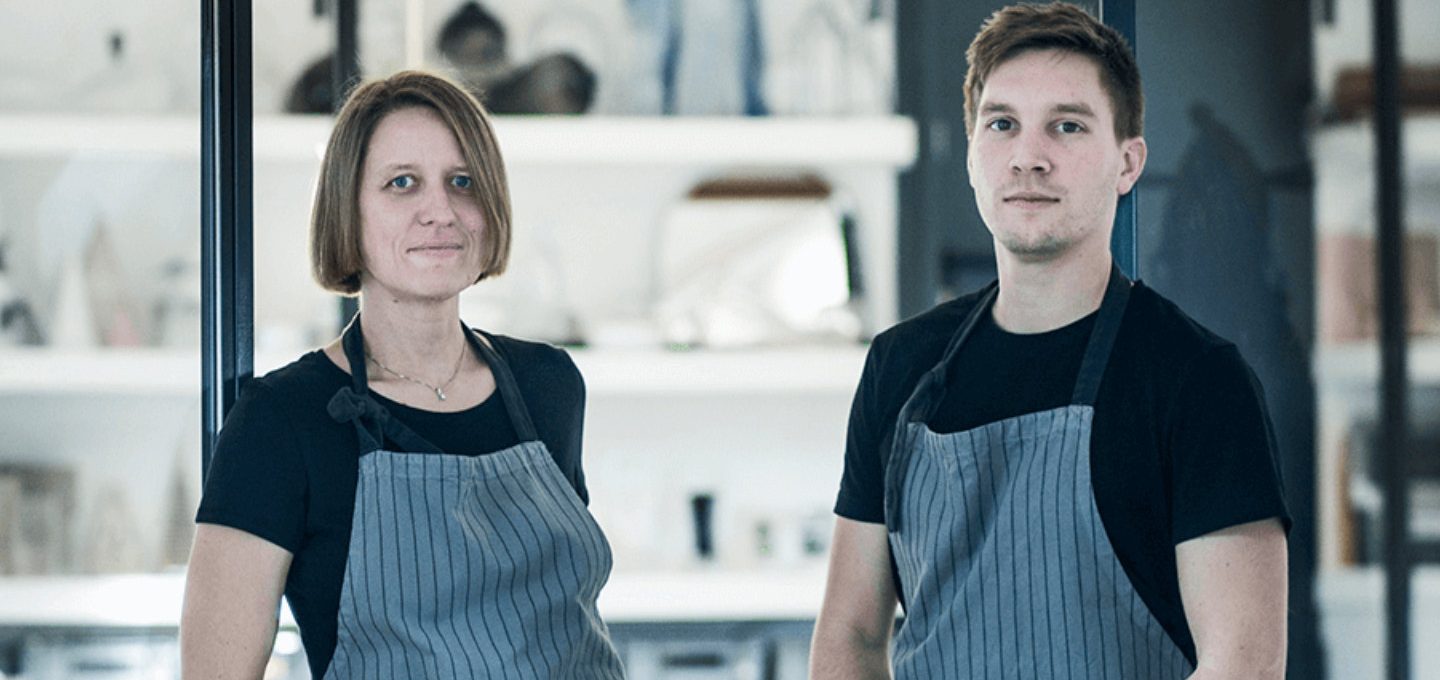Nina Ruthe and David Antonin of Design Studio Niruk love risking experiments and developing innovative materials while creating designs that exude timeless elegance.
How did you come up with the idea of using a waffle maker to mould glass?
Nina: David and I had signed up for a workshop in Berlin where we were supposed to devise glass-blowing ideas and construct experimental shapes against the clock. They told us to bring whatever materials we wanted to use with us. I thought it would be cool to crimp something so I started looking on the internet and came across some old waffle makers. That’s how it all started.
David: We started out with two and now we have six, with different patterns. I also took a sandwich toaster to the workshop. That’s what we used to make our triangular vases.

Are there any particular places in Cologne where you go to look for innovative tools like that?
Nina: We always stop when people have put things out for bulky waste collection. And I’ve been going to the recycling centre a lot recently because I’m doing up a little house. I’m always amazed by all the things people throw away…
You try things without knowing whether they’ll actually work. How high is your success rate?
David: Oh, there are plenty of things that don’t work. Once, we experimented with porcelain door handles. We’d moulded a few things but they exploded during firing. An entire stack blew up, which was a bit of a setback. I’d say 50% is “We could do this but we could just forget about it.”
What thing gave you the greatest sense of success?
David: For me, it was the interlocking, modular moulds we used to blow glass. Some of them were made of wood and we were incredibly nervous because we didn’t know how the wood would behave. We thought it might burn away completely. But that’s how our Falda vase came about. The wooden mould turned into a nice pile of charcoal, we found ourselves surrounded by impenetrable smoke and we set off the fire alarm.
Failures are part of the process. You have to move back and forth as the idea develops into the actual product.
David Antonin
Nina: The good thing is we’re constantly meeting people who are just as passionate as us. In that case, it was a glass-blower who’s actually an artist. Of course, it’s not good if the blower can’t see anything so we had to open the doors quickly to get rid of the smoke. But he didn’t really care about the smoke – the result was the important thing.
Do you get depressed when things go wrong?
David: Not at all. It’s part of the process. You have to move back and forth as the idea develops into the actual product, as you get closer to it. We developed a material called Corcrete – a mixture of concrete and recycled cork that looks like terrazzo. We’ve been working on it for ten years and it’s taken until now to find a suitable manufacturer (HARTIS in Belgium) and be able to sell it properly.

Your work is very sensory. What’s your approach? Do you start off with an idea and then get it commissioned?
Nina: It can be one of two ways. Either we develop projects ourselves like with the waffle maker. That’s a sensory approach where we try things out to get inspiration for future commissions. Or we get a brief and design something that fits it. And there has been a lot of demand in recent years for products that focus on texture, feel and sensory appeal, which has worked out well for us.
David: It’s a planned experiment, like a lab set-up. Many projects run for several months. And we also offer sustainability consultancy services for our clients, like Miele, which entails quite a bit of research.
Is that what brought you together as a team? Your shared love of experimenting?
David: I’d say so. Our passion for materials and shapes. If I think about how we design, it’s relatively quick, that first idea and then the decision as to whether it has potential or not.
You’re designers, you design aesthetically pleasing things. What do you find aesthetically pleasing?
Nina: Beauty lies in the eye of the beholder, as they say. But I don’t think we’d work together if we didn’t have a similar idea of what’s aesthetically pleasing.
David: I think what makes our work special is that the items have a certain elegance but still blend in. Even though they’re organic, each shape is somehow self-contained. And they all have a special sensory element – their appearance changes depending on how the light falls on them or how they’re positioned. You never bore of looking at them.

Sustainability is extremely important to you and you focus on sustainable materials in your university teaching. How do you go about raising awareness of this issue among the new generation of designers?
David: We don’t actually need to make our students aware of the issue. At the moment, it’s more the other way around. We did a glass project with them in the summer and we kept on having to say, “Be free, try things out just so you can familiarise yourself with the materials.” Thinking about the energy you need to make glass can quickly inhibit people and it’s something we’re always asking ourselves, “What is sustainability for us?” Above all, it’s durability. Things that last a long time and that we use – and enjoy using – for a long time.
Too often, sustainable design is just upcycling and recycling. That can’t be the solution.
Nina Ruthe
Nina: Too often, sustainable design is just upcycling and recycling. That can’t really be the solution because you can’t recycle the materials an infinite number of times. If you use recycled material to produce something but it only lasts for five years, it only makes sense for a small portion of products.
David: When it comes to advising big business, small details can make quite a difference. For instance, if a mass producer replaces foam rubber on a handle with cork.
So it’s more a case of convincing students not to be too dogmatic?
Nina: Well, you have to develop the necessary knowledge first. You can’t just say, “I’m not going to work with glass or metal because it uses too much energy” or “We’re only going to produce chairs made from spruce timber people have thrown away.” That’s not the solution; it won’t work in mass production. I think ideas like that are great for community centre or DIY projects but they bear no relation to our profession. That’s a really important point. If you’re talking to big clients that manufacture enormous quantities of their product, you really need to develop very different concepts.
What does Cologne mean to you as designers?
Nina: I think Cologne’s a great place to be based. Obviously, the IMM international furniture fair that’s held here is a factor. We’ve got lots of colleagues here who also work for international clients from the furniture sector. There’s a lot of communication between us all and we meet up on a regular basis. We know the scene pretty well. That’s partly thanks to Sabine Voggenreiter, who curates projects like Passagen and is forever working to bring people together and support them.
David: Cologne is in a fantastic location. There are lots of universities, museums and trade fairs in the region and you can get to Frankfurt, Düsseldorf and even Belgium and Holland quickly.
Nina: It’s always easy to contact people like if you want to find out about funding opportunities. I love that about Cologne – everyone’s so open and I can just ask anyone what I need to know. I was a member of Köln Design too, when I was starting out. You just know lots of people so you’ve got a network.
David: We’ve taken part in several group showcases at the IMM. We want to exhibit in Milan and we’d love to exhibit at Passagen!
Have you got a bestseller?
David: At the moment, it’s the Lily candlestick we created for Bolia. When our Bramble vase came out, it was one of the Covid peak periods. It sold well online but we definitely noticed the effect.
Nina: In these times of crisis, lots of businesses have been repositioning themselves. Everything is about sustainability. You have to carve out your niche. But we’ve got enough work.
What’s more important to you? Aesthetics or functionality – like with your portable Stammtisch table?
Nina: I’ve really very proud of our Stammtisch table. We produce it with a local sheltered workshop and people can order it online in our webshop or at Apparel in the Ehrenfeld district of Cologne. It was the first mini-product that we designed together.
David: My highlight was Corcrete. Because it took so long and we’ve finally finished now.
Nina: And when clients we’d never have expected come to us and you wonder what made them think of us. That always makes us really happy.
What other innovative materials like Corcrete are you working on?
David: Whenever we’re in the production phase, be it bending wood or working with a stonemason, there’s always something new and it’s always fun.

If Cologne were a material, what would it be?
Nina: I’d go for something that’s actually ugly but still has beauty.
David: I was just thinking of basalt, that smooth stone. It’s got lots of holes, it’s a bit dark, a bit dirty but still natural and somehow nice to look at.
Nina: I was thinking of those recycled plastic slabs that have those brightly coloured flakes in them. Sanded down really smooth, and really colourful. A bit like confetti.
What have you got planned for 2023?
Nina: It’s our tenth anniversary. We’re hoping 2023 will bring lots of new customers and a continuation of the good working relationships we have with our existing customers. Just to be able to carry on doing our thing together – that’s what we’re hoping for.
Design Studio Niruk, Burgstr.21, 50354 Hürth

0 comments on “A love of experiments and the little details: Design Studio Niruk”